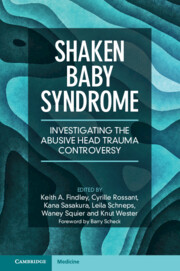6 results
Chapter 17 - Shaken Baby Syndrome
- from Section 3 - Science
-
-
- Book:
- Shaken Baby Syndrome
- Published online:
- 07 June 2023
- Print publication:
- 08 June 2023, pp 259-274
-
- Chapter
- Export citation
Chapter 5 - Shaken Baby Syndrome
- from Section 2 - Medicine
-
-
- Book:
- Shaken Baby Syndrome
- Published online:
- 07 June 2023
- Print publication:
- 08 June 2023, pp 85-104
-
- Chapter
- Export citation
Chapter 15 - When Lack of Information Leads to Apparent Paradoxes and Wrong Conclusions
- from Section 3 - Science
-
-
- Book:
- Shaken Baby Syndrome
- Published online:
- 07 June 2023
- Print publication:
- 08 June 2023, pp 236-248
-
- Chapter
- Export citation
Chapter 6 - Shaken Baby Syndrome or Benign External Hydrocephalus
- from Section 2 - Medicine
-
-
- Book:
- Shaken Baby Syndrome
- Published online:
- 07 June 2023
- Print publication:
- 08 June 2023, pp 105-128
-
- Chapter
- Export citation

Shaken Baby Syndrome
- Investigating the Abusive Head Trauma Controversy
-
- Published online:
- 07 June 2023
- Print publication:
- 08 June 2023
2.9 - Imaging of the Head
- from Section 2 - Diagnosis, Assessment, Investigation, Monitoring and Data Interpretation
-
-
- Book:
- Intensive Care Medicine
- Published online:
- 27 July 2023
- Print publication:
- 01 December 2021, pp 61-67
-
- Chapter
- Export citation

